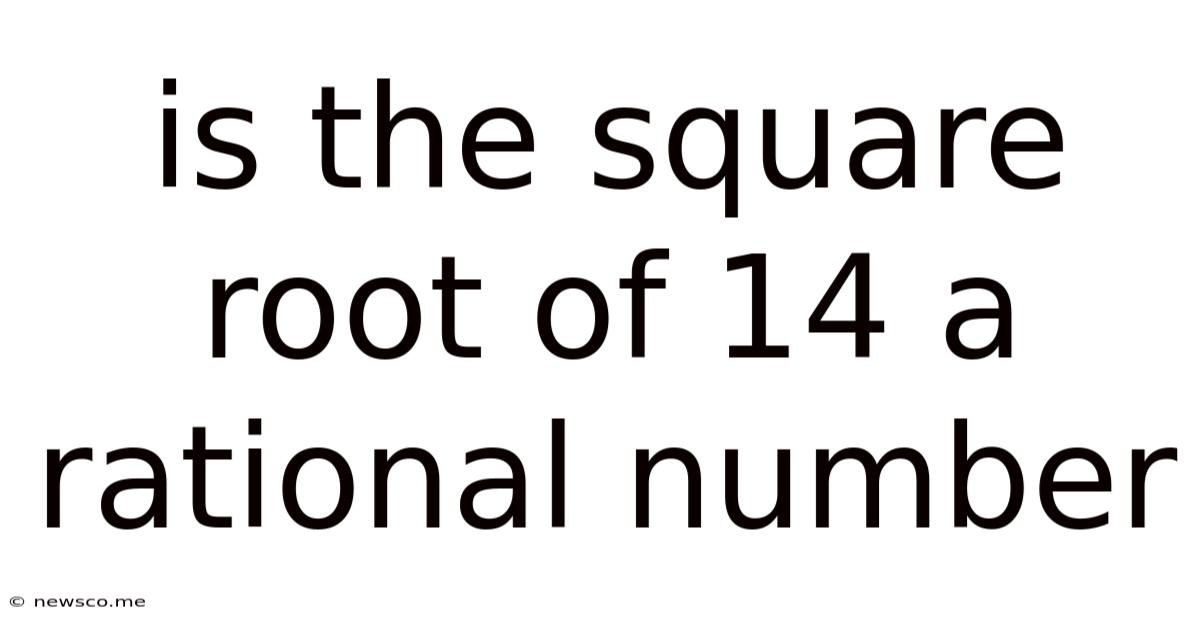Is The Square Root Of 14 A Rational Number
News Co
May 07, 2025 · 5 min read

Table of Contents
Is the Square Root of 14 a Rational Number? A Deep Dive into Irrationality
The question of whether the square root of 14 is a rational number is a fundamental concept in mathematics, touching upon the core principles of number theory. Understanding this requires a solid grasp of rational and irrational numbers. This article will not only answer this question definitively but will also explore the broader context of rational and irrational numbers, providing you with a comprehensive understanding of the subject.
Understanding Rational Numbers
A rational number is any number that can be expressed as the quotient or fraction p/q of two integers, a numerator 'p' and a non-zero denominator 'q'. Crucially, the decimal representation of a rational number will either terminate (e.g., 1/4 = 0.25) or eventually repeat (e.g., 1/3 = 0.333...). Examples of rational numbers include:
- Integers: All whole numbers, both positive and negative (e.g., -3, 0, 5). These can be expressed as fractions with a denominator of 1.
- Fractions: Numbers expressed as a ratio of two integers (e.g., 2/5, -7/12, 10/1).
- Terminating Decimals: Decimals that end after a finite number of digits (e.g., 0.75, -2.5, 3.125).
- Repeating Decimals: Decimals with a sequence of digits that repeat infinitely (e.g., 0.333..., 0.142857142857...).
Delving into Irrational Numbers
An irrational number is any real number that cannot be expressed as a fraction p/q, where p and q are integers, and q is not zero. The decimal representation of an irrational number is neither terminating nor repeating; it continues infinitely without any repeating pattern. Famous examples of irrational numbers include:
- π (Pi): The ratio of a circle's circumference to its diameter, approximately 3.14159...
- e (Euler's number): The base of the natural logarithm, approximately 2.71828...
- √2 (Square root of 2): The number which, when multiplied by itself, equals 2. This is a classic example used to demonstrate the existence of irrational numbers.
Proving the Irrationality of √14
Now, let's address the central question: Is √14 a rational number? The answer is no, √14 is an irrational number. We can prove this using a method similar to the proof by contradiction used to demonstrate the irrationality of √2.
Proof by Contradiction:
-
Assumption: Let's assume, for the sake of contradiction, that √14 is a rational number. This means it can be expressed as a fraction p/q, where p and q are integers, q ≠ 0, and p and q are in their simplest form (meaning they have no common factors other than 1).
-
Squaring Both Sides: If √14 = p/q, then squaring both sides gives us 14 = p²/q².
-
Rearrangement: We can rearrange this equation to: 14q² = p².
-
Deduction about p: This equation tells us that p² is an even number (since it's equal to 14 times another integer). If p² is even, then p itself must also be even. This is because the square of an odd number is always odd.
-
Substituting and Simplification: Since p is even, we can express it as p = 2k, where k is another integer. Substituting this into the equation 14q² = p², we get:
14q² = (2k)² 14q² = 4k² 7q² = 2k²
-
Deduction about q: This new equation tells us that 2k² is divisible by 7. Since 2 is not divisible by 7, k² must be divisible by 7. And if k² is divisible by 7, then k itself must be divisible by 7.
-
Contradiction: We've now shown that both p and q are divisible by 7. This contradicts our initial assumption that p and q are in their simplest form (have no common factors). This contradiction means our initial assumption that √14 is rational must be false.
-
Conclusion: Therefore, √14 is an irrational number.
Further Exploring Irrational Numbers and their Properties
The irrationality of √14 highlights the richness and complexity of the number system. Here are some further points to consider:
-
Density of Irrational Numbers: Irrational numbers are incredibly abundant. Between any two rational numbers, no matter how close they are, there are infinitely many irrational numbers.
-
Uncountability: While the set of rational numbers is countable (meaning you could theoretically list them all, though it would take forever), the set of irrational numbers is uncountable. This means there are infinitely more irrational numbers than rational numbers.
-
Approximations: Although we cannot express irrational numbers as exact fractions, we can approximate them to any desired degree of accuracy using decimal expansions or continued fractions.
-
Applications in Geometry: Irrational numbers frequently appear in geometric contexts. The diagonal of a square with side length 1 is √2, the circumference of a unit circle is 2π, and so on. These examples demonstrate that irrational numbers are not merely abstract mathematical curiosities but have significant practical relevance.
Conclusion: The Significance of Irrational Numbers
The determination that √14 is irrational reinforces the understanding of the fundamental structure of numbers. While seemingly abstract, the distinction between rational and irrational numbers is crucial in various mathematical fields, including calculus, geometry, and number theory. The concept underlies many important mathematical theorems and proofs, and its understanding is essential for a deeper appreciation of the mathematical world around us. The seemingly simple question of whether √14 is rational reveals a deep and fascinating aspect of mathematical reality. The elegant proof by contradiction provides a powerful tool for exploring the properties of numbers and solidifying our understanding of their inherent characteristics.
Latest Posts
Related Post
Thank you for visiting our website which covers about Is The Square Root Of 14 A Rational Number . We hope the information provided has been useful to you. Feel free to contact us if you have any questions or need further assistance. See you next time and don't miss to bookmark.